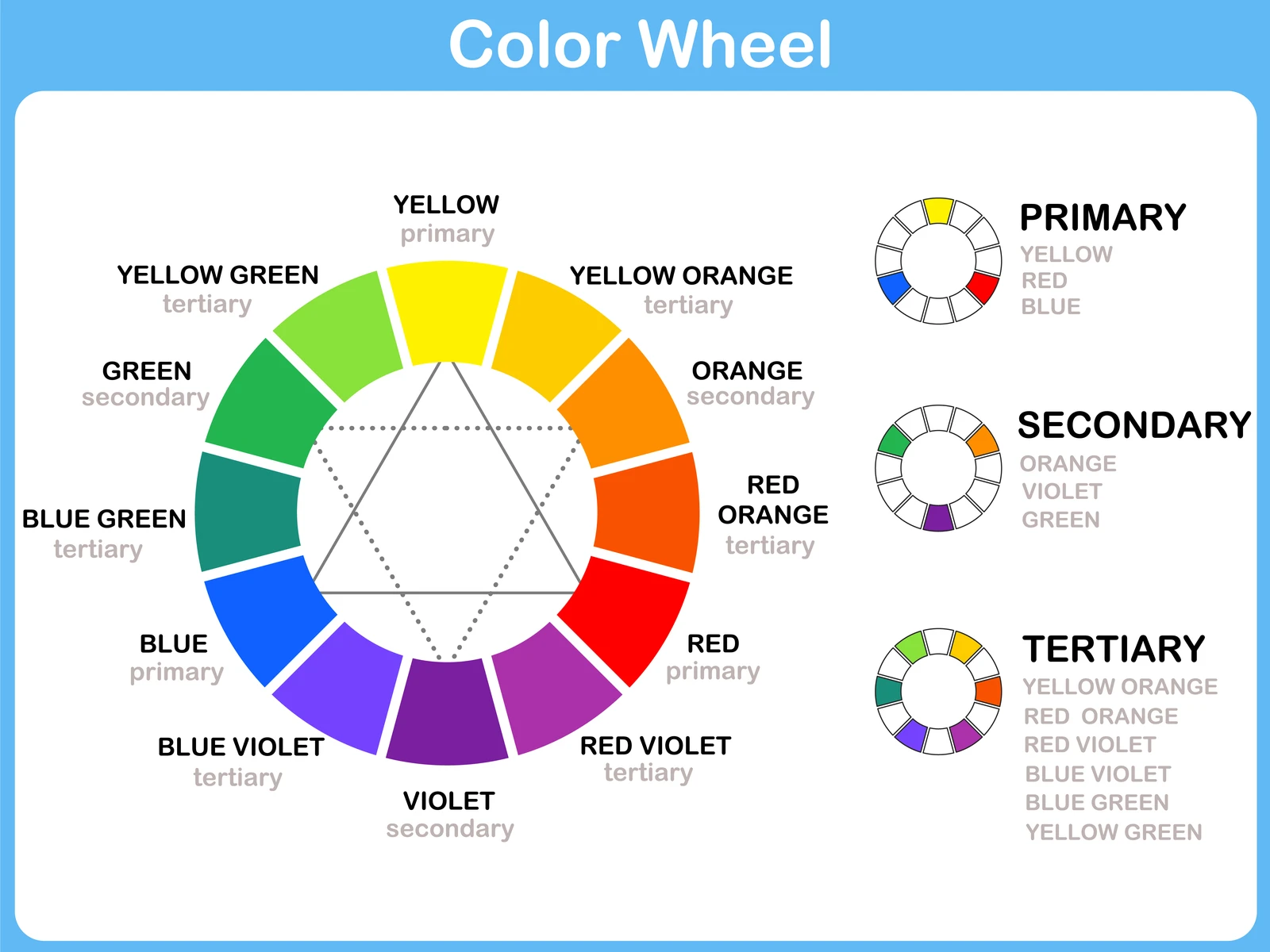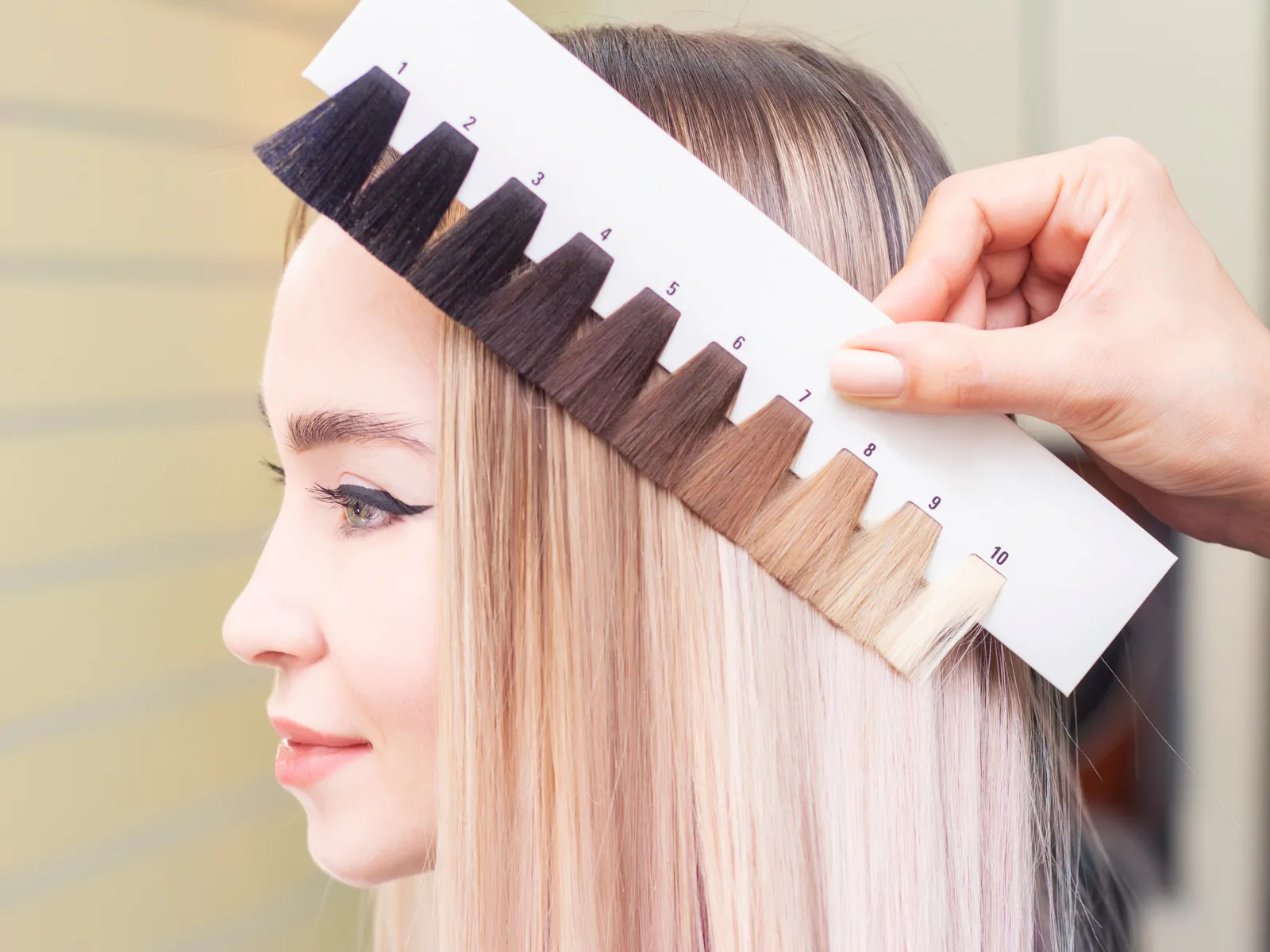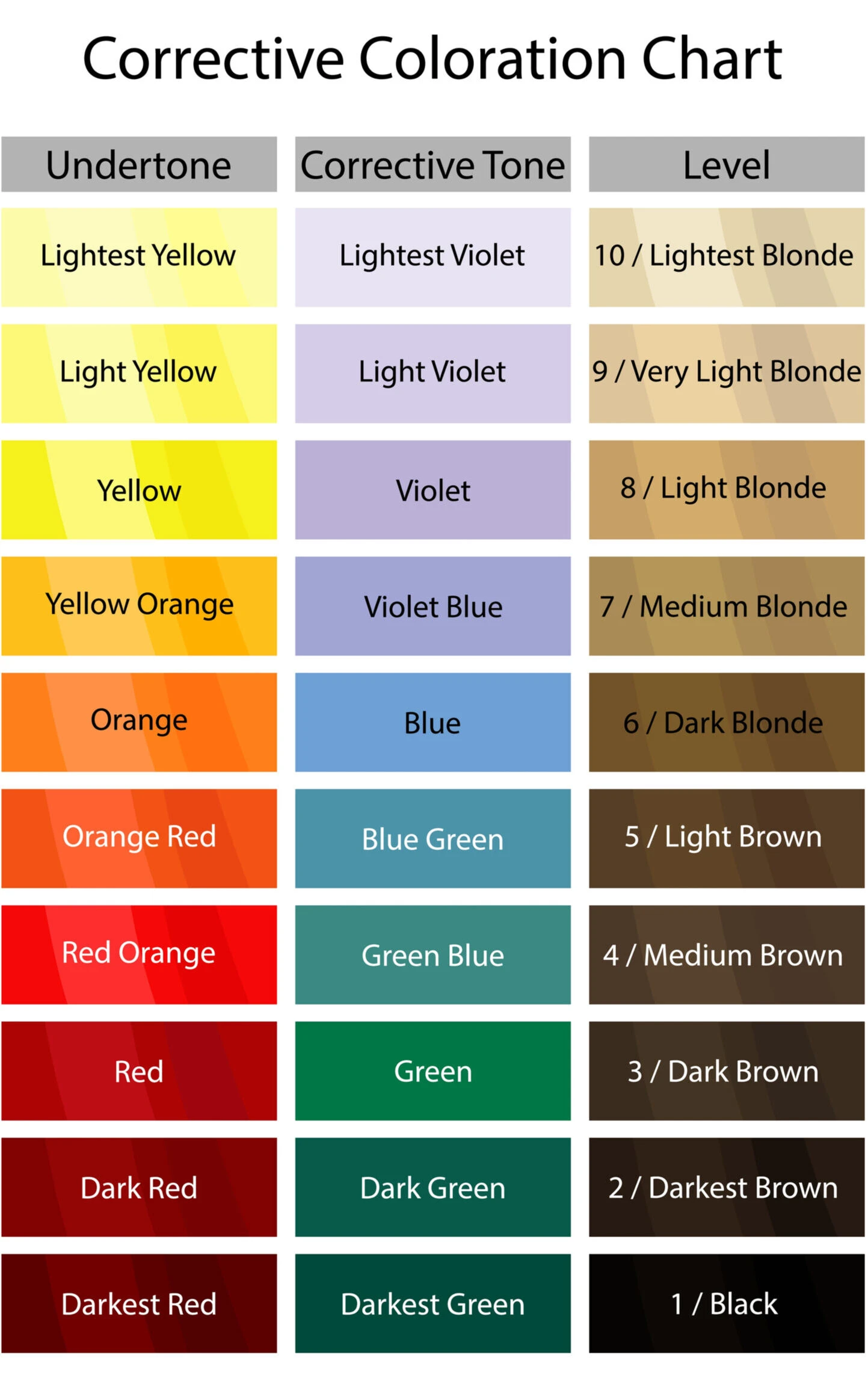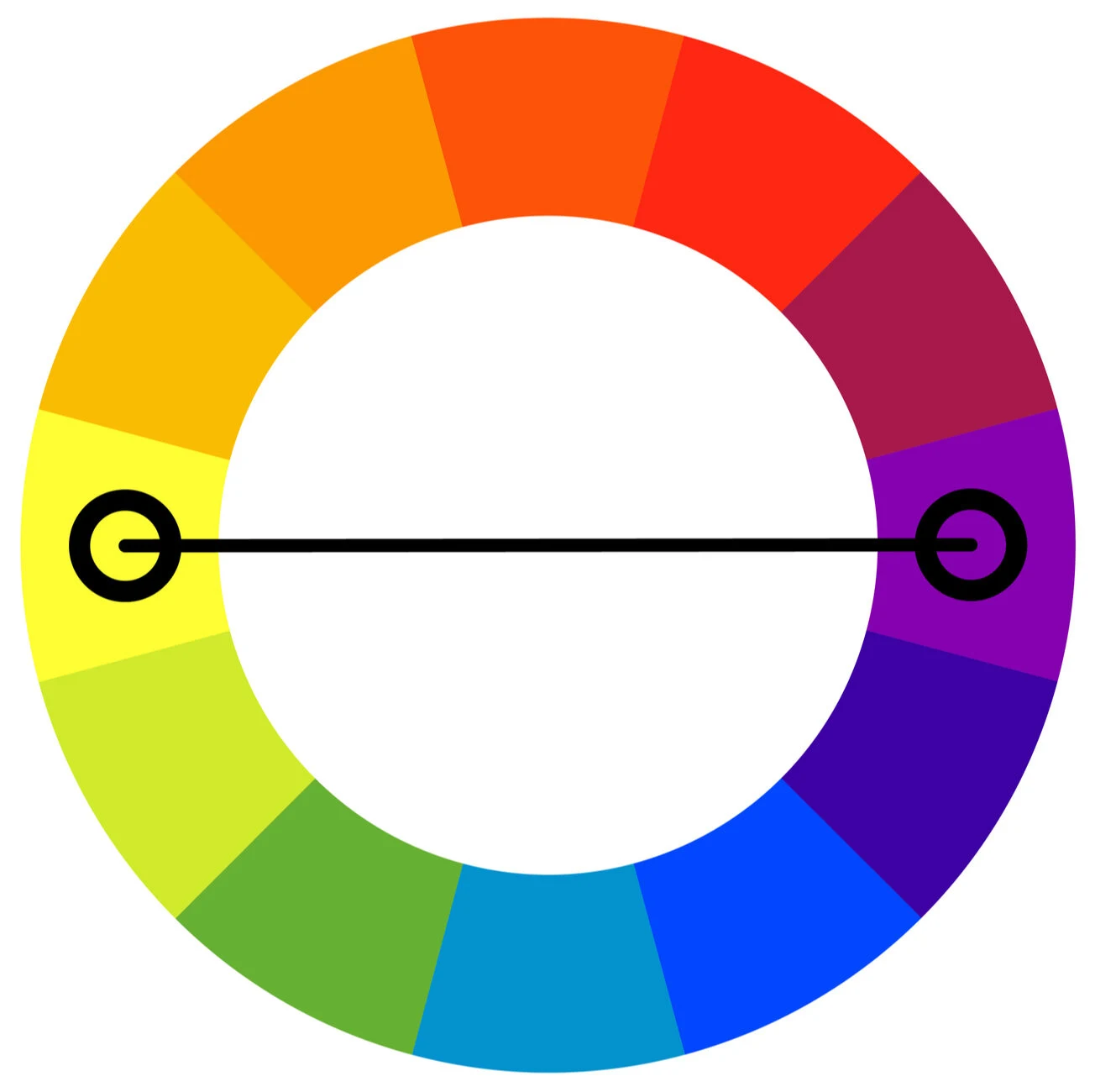Jump to:
Color wheel hair theory is really simple and relies on basics you might’ve learned in elementary school art class. Learn how to use the color wheel to locate the most flattering shades for your skin tone while neutralizing unwanted tones in our guide to color wheel hair theory.
From finding complementary shades that go well together to locating direct color opposites that neutralize brassy tones, colorists have been using the color wheel hair theory to perfect client color for decades.
Now, you can apply this knowledge to pinpoint the right shade for you!
What Is Color Wheel Hair Theory?

aekikuis/Shutterstock
The color wheel hair principles are the same basics you probably learned in art class. On a color wheel, all hues and shades are laid out in a spectrum just like you’ll find in a rainbow: Red, orange, yellow, green, blue, indigo, and violet.
This ordered spectrum on the color wheel tells us exactly which colors go well together (analogous colors), which ones will cancel other colors out (complementary colors), and which colors are best suited for certain undertones (warm/cool).
Colorists use this spectrum or wheel to help identify the colors that will be the most flattering for your undertones (which can be warm, cool, or neutral) and to neutralize and tone unwanted colors from your hair to arrive at the perfect shade.
The really cool thing about the color wheel is that it provides easy solutions for hair color issues based on color theory.
Whether you’re not sure which hair color will look right on you or have some unwanted brassy, yellow, or other tones in your hair after bleaching, the color wheel holds all the answers.
You just need to learn how to “read” the wheel and learn the basics of color theory to apply color wheel hair theory to find your perfectly toned shade!
We’ll show you how to use color wheel hair theory to find the most flattering shades for your skin tone and undertones, plus how to neutralize unwanted tones to get a pure, true shade.
Using Color Wheel Hair Theory to Find Flattering Shades

lev.studio/Shutterstock
Color wheel hair theory at its simplest can show you which colors will look best on your skin’s undertones. Your undertones can be warm, cool, or (more rarely) neutral.
Picking hair colors that match the warmth or coolness of your undertones will result in a more flattering shade that won’t clash with your skin tone. Splitting the color wheel in half shows us which colors are warm and which are cool.
Once you’ve determined whether your undertones are warm, cool, or neutral, you can easily pick colors from the correct side of the wheel to find a flattering hue for you.
If you’re not sure about your undertones, take a quick quiz to learn if you have cool, warm, or neutral undertones: What Color Hair Looks Best On Me?. Then read below to learn more about the most flattering colors for different undertones.
Warm Colors for Warm Undertones
Yellow, orange, red, and pink are the warm colors on the color wheel. In color wheel hair theory, those colors show you the underlying tones you need in natural-looking hair colors as well as vivid bright colors to look flattering on you.
If you have warm undertones (look best in gold jewelry, warm color clothing, and have greenish colored veins), you need a warm shade of hair color to avoid the color “clashing” with your skin.
No matter which color you choose, you’ll want to keep yellow, orange, red, or pink undertones in the color to keep it warm and flattering. That means cool-toned ash blondes are out, as well as violet platinums and blue-blacks.
Instead, opt for these colors to flatter your warm undertones:
- Warm blondes: Golden, strawberry, honey, and caramel blondes
- Rich reds: Ginger, copper, auburn, and cinnamon reds
- Golden or reddish browns: Chestnut, coffee, bronze, and mahogany browns
- Warm black: Black with reddish or golden undertones for warmth
- Metallics: Rose gold and yellow golds
In addition to these natural hair colors, vivid yellow, orange, red, and pink shades will look great on you if you decide to venture out with a brighter color.
Cool Colors for Cool Undertones
Green, blue, and violet are the cool-toned colors on the color wheel. Hair colors with these underlying tones will look best on anyone with cool undertones. If silver looks better on you than gold, your veins appear bluish, and cool-toned clothing looks best on you, you likely have cool undertones.
Even if you’re not planning on wearing an actual vivid green, blue, or violet hair color, these helpful color wheel hair principles still apply. You’ll be looking for colors that feature these hues as undertones if you’re looking for a natural hair color.
For example, ash blondes and browns feature green, violet, and gray undertones. Cool black shades feature blue and violet undertones. Platinum blonde features violet and gray undertones.
There are tons of color options that look great on cool undertones, but warm colors are a definite no-no. Skip warm, golden colors like copper red, honey or golden blonde, chestnut brown, or reddish browns to stay in the cool zone.
These colors will look best on cool undertones according to tried-and-true color wheel hair theory:
- Cool blondes: Platinum, white, sandy, or ash blondes
- Blue/violet reds: Maroon, burgundy, cool auburn, and raspberry reds
- Taupe and ash browns: Ash, taupe, dark chocolate, and mushroom browns
- Cool-toned blacks: Blue-black, violet-black, and emerald-blacks
- Metallics: Glittering silver and gunmetal gray shades
In addition to these natural colors, green, blue, and violet colors will look great on cool-toned individuals who want to rock a vivid hue.
Neutral Colors for Neutral Undertones
Neutral colors aren’t on the color wheel, but still apply to color wheel hair theory. If your undertones are neutral (a mix of both warm and cool undertones), you have a little more freedom and wiggle room when it comes to picking flattering shades.
Both warm and cool colors can look good on neutral undertones because you have features of both warm and cool undertones. Still, you don’t want to choose a color that’s too warm or too cool, which can clash with some of your undertones.
Opt for more neutral colors that carefully balance warmth and coolness for the most flattering effect.
That means very warm colors, like golden or caramel blonde, copper red, or chestnut brown won’t be as attractive. Very cool colors, like violet platinum, ash blonde and ash brown, and blue-black won’t work well, either.
For the most flattering look, opt for neutral-friendly colors that include both warm and cool colors from the color wheel:
- Neutral blondes: Wheat, champagne, and butter blondes
- Neutral reds: Raspberry, auburn, scarlet, and merlot reds
- Neutral browns: Mocha, chocolate, beige, and mushroom browns
- Neutral blacks: True black with limited warm/cool undertones
Using Color Wheel Hair Theory to Tone and Neutralize Color

Sidhe/Shutterstock
One of the most common ways colorists apply color wheel hair theory is to tone and neutralize unwanted colors. After bleaching your hair, you may be left with undesirable brassy, yellow, or even blue/green tones in your hair.
It all depends on the color your hair was before bleaching and how long your hair was allowed to process, or lift. The color wheel makes it easy for stylists to tone and “cancel out” unwanted colors in the hair by applying a neutralizing shade to help blend it out.
You can find the neutralizing shades for toning and color correction by looking at each color’s opposite on the color wheel. Colors that are located opposite each other on the wheel are called complementary colors.
When you mix complementary colors, they cancel each other out so you’re left with your intended shade. As you can see in the chart above, colorists choose the shade of color to tone and correct color based on how light or dark your current color is.
To tone yellow out of very light blonde, a very light violet toner is used. To tone redness out of black hair, a very dark green is used.

Oleksandr Panasovskyi/Shutterstock
Here are the color correction basics, courtesy of color wheel hair theory:
- Violet cancels out yellow tones
- Blue-violet cancels out yellow/orange tones
- Blue cancels out orange tones
- Green cancels out red tones
This is where the idea for purple shampoo to help tone brassy blonde comes from. If you see yellowish color peeping through your icy platinum or ash blonde color, the violet pigments in purple shampoo will help cancel those yellow tones out for a purer, cooler-toned blonde.
Likewise, blue shampoo exists to help cancel orange-toned brassiness out of blonde or brown hair colors that occur naturally when these colors are bleached or lightened.
But pigmented toning shampoos aren’t the only application for color wheel hair theory. When you use a violet, blue-violet, blue, or green toner to correct color, you won’t be left with purple, blue, or green hair.
Instead, those colors will go to work canceling out the unwanted color without actually turning your hair the color of the toner. It seems like magic, but it’s just basic color theory at work!
Using Color Wheel Hair Theory to Create Your Perfect Hue
Now that you’ve seen how the color wheel can help you find flattering colors that suit your undertones (warm, cool, or neutral) and to neutralize unwanted colors from bleached or lightened hair, let’s talk about using color wheel hair theory to find the perfect color and shade for you.
- Determine if you’re warm, cool, or neutral. Knowing your undertones is essential to find a base hair color that will suit and flatter you. The wrong color family can highlight skin imperfections, exacerbate redness, wash out your skin color, and generally look “off.” The quickest test is to check your vein color. Greenish veins signify warm undertones, while bluish veins indicate cool undertones. Bluish-green may indicate neutral undertones.
- Choose a base color with the proper warmth/coolness. Once you’ve determined whether your undertones are warm, cool, or neutral, you can use this guide to find the base colors that will best suit you. Warm undertones look better with warm blondes, rich reds, and golden browns. Cool undertones look best with cool blondes, blue- or maroon-toned reds, and ash browns. Neutral undertones look best in balanced shades like wheat or champagne blonde, reds with both warmth and coolness (like auburn or raspberry), and beige or mushroom browns.
- Lighten (if needed) and dye your hair. Depending on how light or dark your current shade is, you may need to bleach your hair to a lighter shade before you apply your chosen flattering color and tone it. Bleaching brings out the natural undertones in your hair color, so this is when you may see unwanted yellow, orange, or red tones pop up. Apply your color mixed with developer to dye your hair. Check the finished result and determine if it needs to be toned and which color you’ll use to cancel out unwanted tones.
- Tone your hair using color wheel hair theory. After dying your hair your chosen color, you may be left with brassiness in the form of yellow, yellow-orange, orange, or even red tones peeking through. Check the color wheel and use the opposite of the unwanted color you see to tone your hair and cancel that color out. Remember: Violet cancels out yellow, blue cancels out orange, and green cancels out red. Use a lighter shade of your toner color according to how light or dark your new color is. Very light colors like blonde need a very light violet toner and darker shades like brown and black need deeper-hued toners.
- Use pigmented toning shampoo to prolong results. Toners are semi-permanent and won’t last forever, so you’ll need a backup plan once your toner begins to fade and those pesky undertones peek through. Pigmented toning shampoo – usually purple or blue – will help you keep brassy yellow and orange tones at bay until it’s time for a touch up. Use your toning shampoo twice a week to banish unwanted brassy tones and keep your color pure.
Color Wheel Hair Theory Is Awesome. Right?
With a flattering color that suits your undertones, you’ll be able to lighten, dye, and tone your color to enjoy a pure, unadulterated shade that precisely matches your goals.
Say goodbye to brassy platinum blonde, orange tones in ash brown, and red undertones in jet black color. With the color wheel, you’ve unlocked the secret tool every colorist uses to perfect and purify color!
Even if you’re not planning on going the DIY route, it’s great to have this knowledge to better understand your stylist’s process. It can also save you extra trips to the salon when you know how to use the color wheel hair theory to properly tone your color without unwanted brass or redness.
Color theory is a staple for artists of all types, and hair stylists and colorists certainly fit the bill. Great color never happens by accident.
A lot of thought, careful processing, and centuries-old color theory goes into giving you the perfect hue with no unwanted undertones! Remember to stick with shades that match your undertones – warm, cool, or neutral.
Then, use the opposite color for any unwanted tones left in your hair after bleaching and dying. You’ll love how pure and flattering your results are, and you have the helpful color wheel hair theory to thank!
